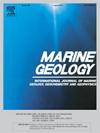Tectono-sedimentary processes shaping the West Sardinian margin and adjacent oceanic basin during the Plio-Quaternary (Western Mediterranean Sea)
IF 2.6
3区 地球科学
Q2 GEOSCIENCES, MULTIDISCIPLINARY
引用次数: 0
Abstract
A seismic analysis of the Plio-Quaternary stratigraphy of the West Sardinian continental margin and adjacent oceanic basin was conducted using single- and multi-channel seismic profiles. Two main chronostratigraphic boundaries have been used: i) the Ms horizon, marking the base of the Pliocene and corresponding to the top of the Messinian evaporites on the lower continental slope and deep basin, and the Messinian erosional truncation on the upper slope and shelf; and ii) the newly identified A0 horizon, marking the base of the Quaternary (2.6 Ma). This study reveals key geological features affecting the Pliocene and Quaternary deposits: a) salt tectonic structures, b) normal faults, c) volcanic structures, d) pockmarks, e) canyon systems, and f) regressive clinoform system. These features are linked to tectono-sedimentary processes such as vertical movements, magmatic activity, halokinesis and sediment dynamics. Vertical movements are associated with the thermal subsidence of the Oligo-Miocene basin opening, water and sediment loading/unloading during and after the Messinian Salinity Crisis, and Pleistocene uplift onshore. These movements resulted in the tilting of the margin, which influenced normal faulting through reactivation of Oligo-Miocene faults, and the Plio-Quaternary depositional patterns. Several normal faults acted as conduits for lower Pliocene magmatic activity and gas migration, forming volcanoes and pockmarks on the continental shelf and upper slope. Salt tectonics in the lower slope and deep basin produced diapirs and rollover structures, significantly impacting the thickness and distribution of Pliocene and, to a lesser extent, Quaternary deposits. Canyons system formation seems to be controlled by the interplay of the Quaternary sea-level fluctuations with the margin's ongoing tilting. Similarly, the regressive clinoform system also results from these two factors, but is further influenced by erosion of uplifted Sardinian onshore areas.
求助全文
约1分钟内获得全文
求助全文
来源期刊

Marine Geology
地学-地球科学综合
CiteScore
6.10
自引率
6.90%
发文量
175
审稿时长
21.9 weeks
期刊介绍:
Marine Geology is the premier international journal on marine geological processes in the broadest sense. We seek papers that are comprehensive, interdisciplinary and synthetic that will be lasting contributions to the field. Although most papers are based on regional studies, they must demonstrate new findings of international significance. We accept papers on subjects as diverse as seafloor hydrothermal systems, beach dynamics, early diagenesis, microbiological studies in sediments, palaeoclimate studies and geophysical studies of the seabed. We encourage papers that address emerging new fields, for example the influence of anthropogenic processes on coastal/marine geology and coastal/marine geoarchaeology. We insist that the papers are concerned with the marine realm and that they deal with geology: with rocks, sediments, and physical and chemical processes affecting them. Papers should address scientific hypotheses: highly descriptive data compilations or papers that deal only with marine management and risk assessment should be submitted to other journals. Papers on laboratory or modelling studies must demonstrate direct relevance to marine processes or deposits. The primary criteria for acceptance of papers is that the science is of high quality, novel, significant, and of broad international interest.
 求助内容:
求助内容: 应助结果提醒方式:
应助结果提醒方式:


